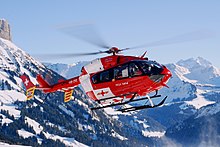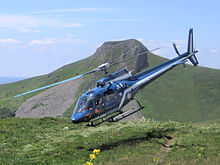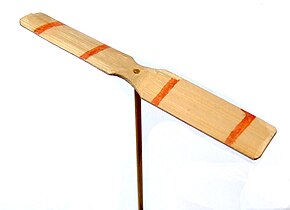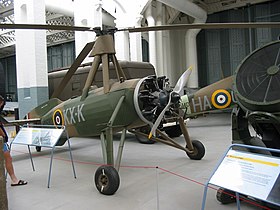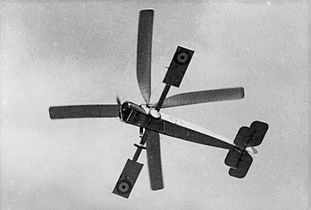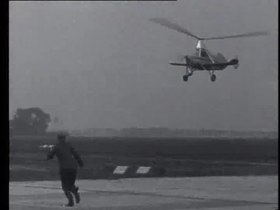Rotary wing aircraft
As a rotorcraft (sometimes rotary wing aircraft or rotorcraft ) refers to aircraft that their lift by at least one rotating around a vertical axis, the rotor obtained. The best-known representatives of this group of aircraft are the helicopters .
Definition and demarcation
The International Civil Aviation Organization ICAO defines the term rotary wing aircraft as follows:
Rotorcraft . A power-driven heavier-than-air aircraft supported in flight by the reactions of the air on one or more rotors.
" Rotary wing aircraft . A motorized aircraft heavier than air that flies as a result of the air reacting to one or more rotors. "
In Germany, the rotary wing aircraft form a separate aircraft class , which can be recognized by an aircraft number starting with DH . Recently, however, more and more light gyroplanes have been registered as motorized aerial sports equipment .
Occasionally, the rotorcraft, since they do not because of the higher density than air travel but to fly , as a subset of the aircraft considered, the actual aircraft are then for better definition than fixed-wing aircraft , fixed wing aircraft or fixed wing aircraft designated. However, this classification contradicts both the legal definition and general usage and can therefore be regarded as out of date. Alternatively, you can also gyrocopter as a common subclass designate of aircraft and rotorcraft, since their takeoff and landing principle is similar to the aircraft.
Types
helicopter
Helicopters have one or more driven (almost) horizontal rotors that generate lift and propulsion . The lift is regulated by collective rotor blade adjustment , the lateral movement (forwards / backwards as well as sideways flight) through the cyclical rotor blade adjustment. For helicopters with only one main rotor , a vertical tail rotor is required to compensate for its torque (see tail rotor configuration ).
In most helicopters, if the engine fails, the rotor blades continue to turn due to the airflow and still generate enough lift to enable the aircraft to make a safe emergency landing. This principle is called autorotation .
Gyroplane

In the case of the gyroplane, also called autogyro , a rotor that is driven in autorotation by the airstream, not by an engine, provides the lift. The rotor functionally replaces the rigid wing of the fixed wing aircraft. A traction or thrust engine must provide propulsion; a tail rotor is not necessary due to the passive drive of the main rotor.
Helicopter
Flight wrenches also generate their propulsion by thrust or pulling engines. In contrast to the gyroplane, the main rotor that provides lift is also driven directly by an engine. Aircraft are therefore a hybrid of a helicopter and a gyroplane.
Hybrid of rotary and fixed wing aircraft
Composite helicopter
The composite helicopter is a special form of the helicopter , which also has fixed wings , also in the form of stub wings. These take over part of the lift when cruising . When hovering , however, they reduce the performance of the main rotor because they are in its downdraft.
Combination aircraft
The combination helicopter is a further development of the flight helicopter , which - similar to the compound helicopter - has fixed wings . During a vertical take-off, the rotor takes over the lift, during cruising the propulsion or traction engines take over the propulsion, and the wings and rotors take over the lift . When cruising, the rotor can be set to a low resistance and uncoupled or used as an additional wing (e.g. Boeing X-50 and Sikorsky X-wing ). Since the lift in forward flight is not (only) generated by the rotating rotor, higher flight performances are possible than with a helicopter. A current development of this type is e.g. B. the Sikorsky X2 .
Convertible plane
Convertible aircraft, also known as transformation aircraft or transformation helicopters , use the configuration of a helicopter for vertical takeoff. When transitioning to forward flight, they are reconfigured to be a fixed-wing aircraft . In this way they combine the advantages of rotary wing and fixed wing aircraft. The conversion usually takes place by tilting the rotor, which then works as a traction engine - called tilt rotor or tiltrotor (e.g. Bell-Boeing V-22 ). The convertible aircraft also include tilt-wing, tilt -rotor, retractable- rotor and stop-rotor aircraft . Most non- jet powered vertical takeoff aircraft ( VTOL aircraft) are convertible aircraft.
Development history
See also: helicopter development history
The number of natural models for rotary wing aircraft is small compared to that of fixed wing aircraft. The few existing models also all work according to the principle of autorotation - they have no drive and cannot be controlled. It is therefore not surprising that the construction of fully functional rotary wing aircraft has been relatively slow.
Children's toys that function in a similar way to falling maple seeds probably existed in China as early as 4,000 years ago; in Europe, their existence has been proven at least since the 14th century . The first detectable reflections on a man-carrying rotorcraft date from the 15th century : Leonardo da Vinci sketched at 1487-1490 "in its so-called Paris Manuscripts " the flight screw , an aircraft, consisting of a platform with a vertical mast, to which a type Archimedean Screw rotates.
In the 18th and 19th centuries several designs followed by different people, but their implementation failed, among other things, because the steam engines of the time had insufficient power density and therefore no suitable drive was available. The use of coaxial rotors or tandem rotors at that time (or the combination of main and tail rotor that is widespread today) shows, however, that the need for torque compensation was already known at that time. When gasoline engines became increasingly available at the beginning of the 20th century, the first successes could finally be recorded. The first flights were short and uncontrolled. a. the development of the swash plate so that around 1930 flights lasting several minutes could be carried out, covering distances of several hundred meters.
- Gyroplane: principle and first airworthy models
Flying screw : sketch by Leonardo da Vinci , around 1490
Cierva C.30 : airworthy model by Juan de la Cierva
Cierva autogyro - autogyro
(1930 demonstration in Croydon , England )Cierva C. 24 (1932, video)
First gyroplane
The Spaniard Juan de la Cierva made a decisive contribution to this . His goal was not the construction of a helicopter, but that of a stall-proof aircraft. To do this, he replaced the rigid wings with a rotor driven by the airstream and thus invented the concept of the gyroplane , which he then marketed under the name Autogiro . In the course of the further development of his early designs, he invented two important new structural components with flapping and swivel joints .
Development of the helicopter
In the early 1930s, Louis Bréguet and Rene Dorand constructed the Gyroplane Laboratory, probably the first usable helicopter that flew stable over a long period of time. It held all international records for helicopters until the Focke-Wulf Fw 61 took the lead in June 1937 . Both models were prototypes and remained unique. The first helicopters built in series were the Flettner Fl 282 and the Focke-Achgelis Fa 223 from 1941 .
Around the beginning of the 1940s, the development of helicopters was increasingly tackled worldwide. Over time, the usual configuration with main and tail rotor established itself as the standard. While the concepts of the gyrocopter and airplane helicopter initially received little attention, the helicopter established itself as a versatile piece of equipment. Well-known examples in the civil sector are the rescue and police helicopters . In the meantime, highly specialized military helicopters are used in the military, depending on the area of responsibility .
Renaissance of the gyroplane
With the beginning of the 21st century, the gyroplane began to gain popularity again. In Germany, this was mainly due to the fact that small and light gyroplanes can now be licensed as microlight aircraft . With the type certification of the HTC MT-03 in October 2003, the foundation stone was laid for a new branch of air sports . In the following years, the number of ultra-light gyroplanes in Germany rose steadily. At the 22nd German championship of microlight pilots in 2011 at the Borkenberge airfield , a separate class was set up for the first time for the gyroplane, in which only two machines took part in the competition.
Helicopter
Also in the 21st century, a use for aircraft helicopters in the military sector began to emerge. The higher speed and range compared to helicopters as well as the lower noise development allow other types of missions. With the Sikorsky X2 , Boeing X-50 and Eurocopter X3 , several test models were created, followed by the possible series model Sikorsky S-97 . As of 2015, Sikorsky / Boeing SB-1 is also under development. The helicopters compete with convertible aircraft such as the Bell Boeing V-22 or the Bell V-280, which is also under development .
See also
swell
- Walter Bittner: Flight mechanics of the helicopter . Technology, the flight dynamics system helicopters, flight stability, controllability. 2nd updated edition. Springer Verlag, Berlin, Heidelberg 2005, ISBN 3-540-23654-6 , Chapter 1: Evolution of the helicopter.
Individual evidence
- ↑ Niels Klußmann, Arnim Malik: Lexicon of aviation . 2nd, updated and expanded edition. Springer, Berlin / Heidelberg / New York 2007, ISBN 978-3-540-49095-1 (first edition: 2004).
- ↑ International Civil Aviation Organization (Ed.): Annex 7 to the Convention on International Civil Aviation . Aircraft Nationality and Registration Marks. 5th edition. July 2003, p. 1 ( Page no longer available , search in web archives: available online, PDF, 336 kB [accessed on May 4, 2011]).
- ↑ The New Universal Lexicon . Bertelsmann Lexikon Verlag, 2007, ISBN 978-3-577-10298-8 , p. 284 .
- ^ Heinz AF Schmidt: Lexicon of aviation . Motorbuch Verlag, 1972, ISBN 3-87943-202-3 .
- ↑ Wilfried Copenhagen a. a .: transpress Lexicon: aviation . 4th revised edition. Transpress-Verlag, Berlin 1979, p. 255 .
- ^ A b Walter Bittner: Flight Mechanics of Helicopters , p. 1
- ^ Heinrich Dubel: Untitled article . In: The time . No. 37 , 2001 ( zeit.de ).
- ↑ Charles Nicholl : Leonardo da Vinci - The biography . S. Fischer, Frankfurt am Main 2006, pp. 271-272, ISBN 978-3-10-052405-8
- ↑ Walter Bittner: Flight Mechanics of Helicopters , p. 4
- ↑ Walter Bittner: Flight Mechanics of Helicopters , p. 3
- ↑ Walter Bittner: Flight Mechanics of Helicopters , p. 6 f.
- ^ Walter Bittner: Flight Mechanics of Helicopters , pp. 8-10
- ↑ Yves Le Be: The True Story of the Helicopter: from 1486 to 2005 . Publishing house Jean Duvret, Chavannes-près-Renens 2005, ISBN 2-8399-0100-5 , p. 10 .
- ↑ UL statistics 2009: No trace of crisis. (No longer available online.) In: aerokurier.de. Motor Presse Stuttgart, November 1, 2010, archived from the original on May 25, 2011 ; Retrieved May 25, 2011 . Info: The archive link was inserted automatically and has not yet been checked. Please check the original and archive link according to the instructions and then remove this notice.
- ↑ German UL Championship 2011. (No longer available online.) In: daec.de. German Aero Club , January 5, 2011, archived from the original on May 25, 2011 ; Retrieved May 25, 2011 . Info: The archive link was inserted automatically and has not yet been checked. Please check the original and archive link according to the instructions and then remove this notice.
- ^ Ralf Aumüller: Sovereign German Masters. In: Westfälische Nachrichten. June 6, 2011, accessed on June 8, 2011 : "Two planes took off from the gyroplanes."
further reading
- Engelbert Zaschka : rotary wing aircraft. Gyroscopes and helicopters. CJE Volckmann Nachf. E. Wette, Berlin-Charlottenburg 1936, OCLC 20483709 , DNB 578463172 .
- US Department of Transportation - Federal Aviation Administration - Flight Standards Service: Rotorcraft Flying Handbook (FAA-H-8083-21), 2000, faa.gov ( Memento of November 5, 2005 in the Internet Archive ) (PDF, 17 MB).
Web links
- Official homepage of the Rotorcraft Commission of the World Air Sports Association FAI

